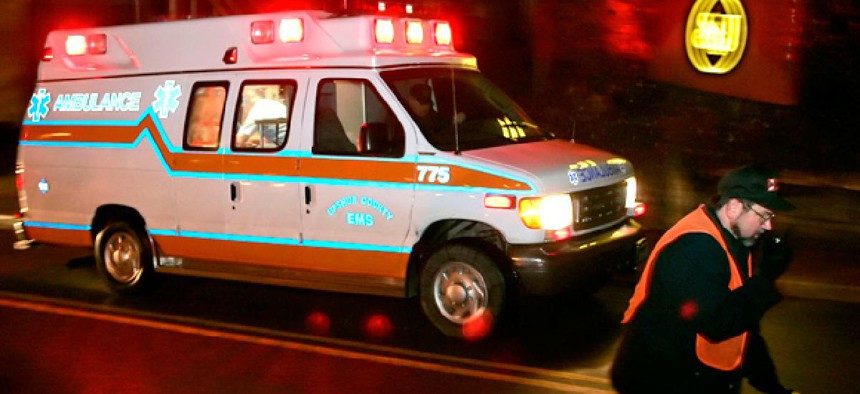Homeland Security to fund next-generation emergency wireless service

George Widman/AP
DHS wants low-cost, interconnected video and data systems for first responders.
The Homeland Security Department is preparing to spend $8 million for prototype wireless services that potentially could synchronize public safety communications systems nationwide without costing billions of dollars, government documents suggest.
“Next-generation tactical wireless broadband” is intended to overcome several challenges authorities and first responders face in trying to exchange data and video during crises, according to an announcement about funding availability.
Of particular concern is the lack of interconnected networks for public safety officials across the country, so critical messages may fail to reach the right people in time. The 18-month effort is expected to establish “the ability to seamlessly roam from public safety networks, commercial networks and [land mobile radio] networks,” while also “connecting users operating on different networks,” DHS officials stated.
The competition for research funding is open to industry, government laboratories, academic institutions and nonprofit organizations. DHS is looking for approaches that could help upgrade existing network services quickly. The objective “is to support immediate technology transition wherever possible, and to create transition paths for new capabilities from the outset,” according to the call for applicants.
Typically, network overhauls are extremely expensive. This program would experiment with sharing emergency communication services among multiple organizations on an as-needed basis to drive down price.
“DHS is seeking cost efficiencies that allow users to leverage existing and emerging commercial and public safety networks (e.g., 4G LTE and public safety networks built by public safety waiver recipients) on a subscription basis,” officials stated. “Use of a subscription model reduces the ownership and operating costs by sharing the network ownership costs across a wider user base.”
At Homeland Security alone, the traditional business model for operating emergency communications “carries a multibillion-dollar price tag across the department,” they added. “This model must give way to a ‘game-changing approach.’ ”
The program is structured so that researchers will tackle the root of each problem separately. Projects in four focus areas will be funded for up to 18 months.
Homeland Security’s current tactical communications systems can handle only slow-speed voice services, so one area of focus will be on providing voice over high-speed Internet for land mobile radios. Engineers also will develop emergency broadband data and video services that are able to interact with commercial smartphones, 4G networks and possibly DHS-developed tools such as biometric devices and license plate readers. The third component involves controlling emergency communications devices remotely. This initiative, for example, would provide the capability to reprogram a device out in the field and wipe data from lost or stolen handhelds.
The final category concerns network integration -- the services that will connect all emergency communications nationwide in the event commercial networks or radio networks jam. The guidelines state that designs should concentrate “on creating a seamless nationwide footprint with high grade of service to meet mission requirements,” including availability “even during periods of high network congestion.”
Applicants must submit white papers describing their strategies by Sept. 7. Homeland Security then will vet the pool of submissions and invite candidates with valuable ideas to submit formal proposals by Nov 26.
The new research into public safety wireless technology is among several ongoing radio procurement projects at Homeland Security.
DHS recently signed a $3 billion deal to obtain new tactical communications for the entire department, along with the White House and the Interior, Justice and State departments. In July, Homeland Security’s Customs and Border Protection began hiring a vendor to recycle thousands of pounds of old radio equipment free of charge.
NEXT STORY: House Dems battle for social media supremacy



